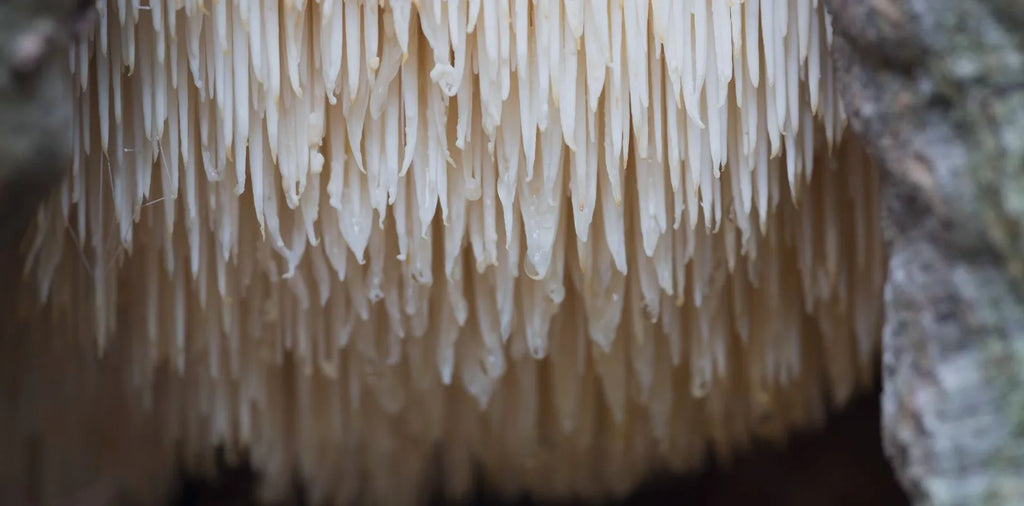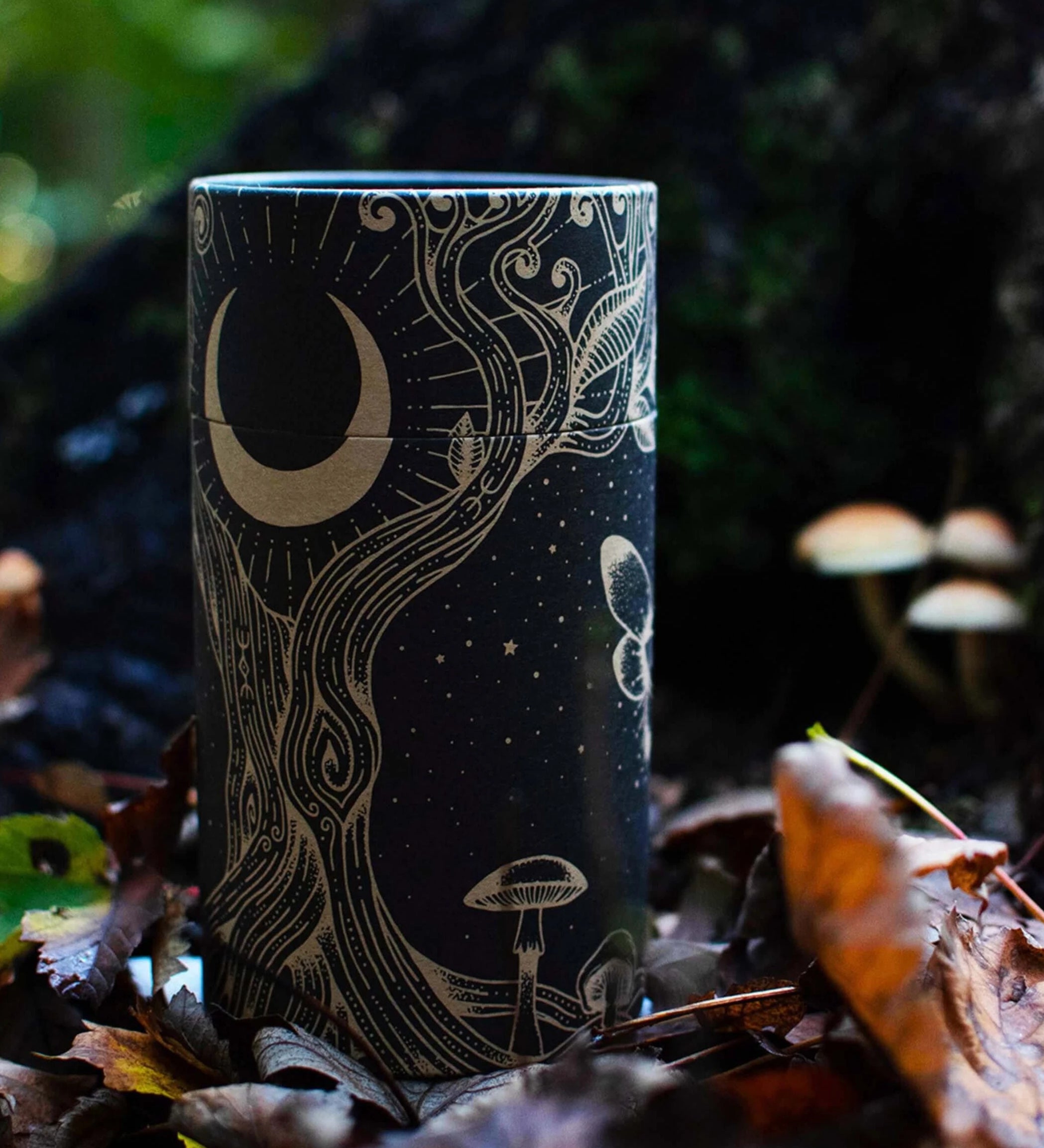How Lion's Mane helps you learn

Lion's Mane or the "lion's mane" mushroom (Latin: Hericium Erinaceus, also called hedgehog's beard or monkey's head mushroom) grows on dead wood and actually has a visual similarity to the mane of a lion. Not only is its appearance unmistakable, but the medicinal effect of Lion's Mane is absolutely unique and cannot be found in this form in any other medicinal mushroom, because: Lion's Mane has the ability to repair nerve cells in your body!
Why is that important?
Nerve cells - you may also know them as neurons - are small excitable cells that record and transmit information using electrical and chemical signals. They are the fundamental elements of our nervous system and enable us to have all kinds of motor and cognitive abilities. So in short, without functioning neurons you can't move or think.
We know the preliminary stage of “not being able to think anymore”. It can be seen, for example, in diseases such as Parkinson's, Alzheimer's and dementia. The cause of these diseases is ALWAYS due to damage and a lack of regeneration of the neurons or their covering, the myelin layer .
The important myelin layer
Myelin covers the nerve pathways like a protective layer and, to put it simply, ensures an optimal signaling pathway. The extent of myelination of our neurons is a unique aspect in which the human brain differs from that of other species. It is responsible for the high processing speeds that underlie our higher cognitive functions and, so to speak, make us human! [ 1-5 ]
Without this layer, our nerves work much slower.

This is also reflected in the symptoms of multiple sclerosis, because in this disease the myelin layer of the nerves is actively destroyed. These include, among other things, gait or balance problems, vision and speech problems or symptoms of paralysis.
And what does this have to do with this mushroom?
Lion's Mane is actually known to reduce the effects of these diseases and generally (i.e. even in healthy people) to improve cognitive abilities such as learning and our memory. ( Kawagishi et al. 2008 , Mori et al. 2009 ). Studies by Fujiwara et al. (2006) also suggest that continuous intake protects against the consequences of reduced blood flow and possibly prevents a stroke.
How does the fungus do this?
Our body contains proteins that are responsible for nerve growth, so-called NGFs (from the English nerve growth factors ). NGFs protect our existing neurons, for example by building the myelin layer. At the same time, they also stimulate the growth of new neurons and their plasticity , which basically corresponds to the definition of learning.
So when our brain produces enough NGFs, everything runs smoothly. A problem only arises when these are no longer produced in sufficient quantities. Then a few neurons in our brain remain uncared for, like in a kindergarten that always has too few teachers. This happens particularly often in older people when the body's overall functions decline somewhat. This is why diseases such as Alzheimer's creep in, especially in older people.
Alzheimer's info card
A large part of this is the loss of the myelin layer, which promotes the formation of so-called amyloid beta plaques . Amyloid beta is a naturally occurring protein in the body that is normally completely broken down. If this process is disrupted (e.g. due to lack of sleep or genetic defects), the proteins clump together and are deposited as plaque on the defenseless nerve cells. ( Gupta, A., Goyal, R (2016) ) If a myelin layer promotes nerve communication, simply put, an amyloid-beta layer does the opposite and even causes nerves to die.
Using the unpronounceable substance dilinoleoyl-phosphatidyl-ethanolamine, the fungus surprisingly protects the nerve cells from death due to the accumulation of these plaques and other stressors, independently of the myelin layer. ( Nagai et al. 2006 , Kawagishi et al. 2008 )
Lion's Mane also stimulates the synthesis of NGFs in the brain, which in turn regulate the formation of the important myelin layer ( Kolotushkina et al. 2003 ). Even taking a few grams of the dried mushroom daily can increase NGF ( Spelmann et al. 2017 ).
Its Latin name Hericium Erinaceus reveals how: The special ingredients Hericenone and Erinacine are precisely the molecular components that have been proven to promote the synthesis of neurons ( Kawagishi et al. 2008 , Fujiwara et al. 2006 ). It is so proven that even supplements are sold as "brain boosters" that contain nothing other than "isolated hericenone and erinacene" from the fruiting body of the Lion's Mane.

We're actually not a big fan of all this isolated stuff because we believe that this often means that the synergistic effect with other ingredients from medicinal mushrooms is lost. In the case of Lion's Mane, the hericenones seem to have such a serious effect that they are also being used as isolated components in supplements. That's pretty amazing. Lion's Mane not only helps people suffering from neurological disorders, but can also prevent and even reverse cognitive decline by stimulating NGF ( Kawagishi et al. 1994 , Lee et al. 2000 ).
These findings, some of which were obtained in animal experiments or in test tubes, were confirmed in a small placebo-controlled double-blind study with 30 participants who suffered from mild cognitive impairment ( Mori et al. 2009 ). Half of the participants received mushroom powder capsules for 16 weeks. Compared to the placebo group, they showed significantly improved mental abilities, which increased with increasing duration of use.
It gets better: Unlike most medications prescribed by the pharmaceutical industry for cognitive function, Lion's Mane has no known side effects. It can be taken every day without any risk of adverse consequences.
Have you ever heard of mushroom coffee? You can find a delicious mushroom latte recipe and 6 benefits that you definitely shouldn't miss here .
Lion's Mane can do much more
Aside from its amazing effect on the brain, the mushroom can do much more. In traditional Chinese medicine it is used for all types of nervous and inflammatory stomach and intestinal problems. Good experiences have also been made here with chronic inflammatory bowel diseases such as ulcerative colitis and Crohn's disease. The fungus promotes the regeneration of damaged mucous membranes and regulates acid production.
In China, it is traditionally recommended to cook the dried fruit bodies with chicken soup for general strengthening and combating old age.

Science reveals why:
As with most other medicinal mushrooms, Lion's Mane also has a strengthening effect on the immune system through its polysaccharides and polypeptides - which we obtain through special extraction conditions - especially in cases of immunodeficiency ( Mizuno et al. 1992,1993 ).
There is also evidence that hericenones and erinacins stimulate the production of defense cells and thus the immune system.
The erinacins in particular also appear to inhibit the growth of the bacteria Heliobacter Pylori and pathogenic yeasts such as Candida albicans in the intestine ( Kawagishi 2005 , Kim et al. 2000 ). These microbes are involved in a variety of diseases, including the development of stomach ulcers and stomach cancer.
Lion's Mane in everyday life
Should you try Lion's Mane even if you think you're pretty clearheaded? - In any case. You don't always have to have mental and physical failures before you can take action. Lion's Mane also helps in healthy people as a prevention, protects against negative consequences of stress and supports many forms of cognitive performance such as information storage, in short learning.
Of course, you can't just buy Lion's Mane in the supermarket in Germany. That annoyed us and that's why we looked for alternatives:
In the picture you can see our first successful Lion's Mane breeding from a substrate bag. We grew the mushroom at home. In your own bathroom. Of course, visitors were always thrilled when they were surprised by the coral-like formations on the edge of the bathtub.

We extracted the fruit bodies we grew ourselves twice. This can be applied to several medicinal mushrooms and extracts the largest proportion of effective ingredients. In contrast to cork-like tree mushrooms such as Chaga and Reishi, Lion's Mane is also excellent in the pan. We even consider it one of our favorite edible mushrooms because its taste and texture are reminiscent of tender chicken meat.
At Lykaia we have developed a " forest coffee " that contains, among other things, Lion's Mane extract. In this case, the extract corresponds to the double extraction in its spray-dried form - of course not grown in your own bathroom but from a certified and ecological mushroom cultivation farm. Our aim was to produce a coffee powder that contains all the valuable active ingredients from the mushroom extracts. We were helped by the fact that the German scientist Susanne Ehlers was able to show in her doctoral thesis that the active ingredient content of extracts from dried mushrooms and those from liquid mycelium cultures is almost identical (Ehlers 1999 ) .
If you've read this far, thank you very much! Leave us a comment if the article was too long or complex for you or if it satisfied your curiosity. This way we can optimize our content and provide you with the best added value!
Sources:
1. Semendeferi K, Lu A, Schenker N, Damasio H. Humans and great apes share a large frontal cortex. Nat Neurosci. 2002;5:272–6. [ PubMed ] [ Google Scholar ]
2. Schoenemann PT, Sheehan MJ, Glotzer LD. Prefrontal white matter volume is disproportionately larger in humans than in other primates. Nat Neurosci. 2005;8:242–52. [ PubMed ] [ Google Scholar ]
3. Bartzokis G. Age-related myelin breakdown: a developmental model of cognitive decline and Alzheimer's disease. Neurobiol Aging. 2004;25:5–18. [ PubMed ] [ Google Scholar ]
4. Bartzokis G. Quadratic trajectories of brain myelin content: unifying construct for neuropsychiatric disorders. Neurobiol Aging. 2004;25:49–62. [ Google Scholar ]
5. Bartzokis G. Brain myelination in prevalent neuropsychiatric developmental disorders: Primary and comorbid addiction. Adolescent Psychiatry. 2005;29:55–96. [ PMC free article ] [ PubMed ] [ Google Scholar ]
6. Kawagishi, Hirokazu & Zhuang, C. (2008). Compounds for dementia from Hericium erinaceum. Drugs of The Future - DRUG FUTURE. 33. 10.1358/dof.2008.033.02.1173290. https://www.researchgate.net/publication/247829010_Compounds_for_dementia_from_Hericium_erinaceum
7. Mori, K., Inatomi, S., Ouchi, K., Azumi, Y. and Tuchida, T. (2009), Improving effects of the mushroom Yamabushitake (Hericium erinaceus) on mild cognitive impairment: a double-blind placebo -controlled clinical trial. Phytother. Res., 23: 367-372. https://doi.org/10.1002/ptr.2634 https://pubmed.ncbi.nlm.nih.gov/18844328/
8. Nagai K, Chiba A, Nishino T, Kubota T, Kawagishi H. Dilinoleoyl-phosphatidylethanolamine from Hericium erinaceum protects against ER stress-dependent Neuro2a cell death via protein kinase C pathway. J Nutr Biochem. 2006 Aug;17(8):525-30. doi: 10.1016/j.jnutbio.2005.09.007. Epub 2005 Oct 27. PMID: 16426828. https://pubmed.ncbi.nlm.nih.gov/16426828/
9. Kolotushkina EV, Moldavan MG, Voronin KY, Skibo GG. The influence of Hericium erinaceus extract on myelination process in vitro. Fiziol Zh. 2003;49(1):38-45. PMID: 12675022. https://pubmed.ncbi.nlm.nih.gov/12675022/
10. Hazekawa, Mai & Kataoka, Aiko & Hayakawa, Kazuhide & Uchimasu, Takeshi & Furuta, Riyo & Irie, Keiichi & Akitake, Yoshiharu & Yoshida, Miyako & Fujioka, Toshihiro & Egashira, Nobuaki & Oishi, Ryozo & Mishima, Kenji & Mishima, Kenichi & Uchida, Takahiro & Iwasaki, Katunori & Fujiwara, Michihiro. (2010). Neuroprotective Effect of Repeated Treatment with Hericium erinaceum in Mice Subjected to Middle Cerebral Artery Occlusion. Journal of Health Science. 56. 296-303. 10.1248/jhs.56.296. https://www.jstage.jst.go.jp/article/jhs/56/3/56_3_296/_pdf
11. Kawagishi, Hirokazu et al. “Erinacines A, B, and C, strong stimulators of nerve growth factor (NGF) synthesis, from the mycelia of Hericium erinaceum.” Tetrahedron Letters 35 (1994): 1569-1572. https://www.semanticscholar.org/paper/Erinacines-A,-B,-and-C,-strong-stimulators-of-nerve-Kawagishi-Shimada/e13f2657e2a532716382b085b5b4a901ce071a18
12. Spelman, Kevin & Sutherland, Elizabeth. (2017). Neurological Activity of Lion's Mane (Hericium erinaceus). Journal of Restorative Medicine. 6. 19-26. 10.14200/jrm.2017.6.0108.
https://www.researchgate.net/publication/321969743_Neurological_Activity_of_Lion%27s_Mane_Hericium_erinaceus
13. Lee EW, Shizuki K, Hosokawa S, Suzuki M, Suganuma H, Inakuma T, Li J, Ohnishi-Kameyama M, Nagata T, Furukawa S, Kawagish H. Two novel diterpenoids, erinacines H and I from the mycelia of Hericium erinaceum. Biosci Biotechnol Biochem. 2000 Nov;64(11):2402-5. doi: 10.1271/bbb.64.2402. PMID: 11193408.
https://pubmed.ncbi.nlm.nih.gov/11193408/
14. Mizuno T, Wasa T, Ito H, Suzuki C, Ukai N. Antitumor-active polysaccharides isolated from the fruiting body of Hericium erinaceum, an edible and medicinal mushroom called yamabushitake or houtou. Biosci Biotechnol Biochem. 1992 Feb;56(2):347-8. doi: 10.1271/bbb.56.347. PMID: 1368310. https://pubmed.ncbi.nlm.nih.gov/1368310/
15. Susanne Ehlers : Studies on the cultivation and pharmacological effects of the edible mushroom Hericium erinaceus. Dissertation. Technical University of Munich. 1999.
0 comments








